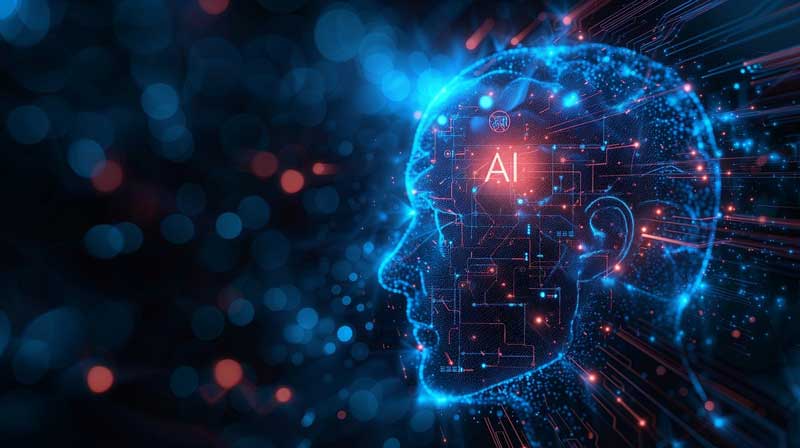

Next Phase of AI in Cybersecurity
Artificial Intelligence and Cybersecurity
Artificial intelligence, commonly known as AI has been around since the 1950s. However, its growth has surged in years due, to advancements in computer technology that have made it more accessible to a range of organizations. This expansion is fueled by the availability of cost-effective computer chips and the vast amounts of data available for training AI systems.
Applications like email spam filters and virtual assistants showcase a glimpse of how AI is being used today. With the increasing digitization of our world, the risk of cyber attacks on interconnected devices and systems is also on the rise underscoring the importance of AI in cybersecurity efforts. By leveraging AIs ability to analyze volumes of data for anomalies and threats organizations are transforming their approach to cybersecurity.
However, incorporating AI into security measures comes with its challenges. While AI offers opportunities to enhance security practices it also introduces vulnerabilities that threat actors can exploit. Some malicious parties have already begun using AI to launch sophisticated cyber attacks globally prompting organizations to adapt quickly to this evolving landscape.
According to findings from the 2021 Middle East CEO Survey, an increasing number of respondents view cyberattacks and data breaches as threats to business growth compared to years. As a result, many organizations are looking to allocate resources toward cybersecurity and data privacy initiatives in response. This heightened awareness underscores the importance for business leaders in staying proactive against cyber threats amidst growing competition, in the realm of intelligence.
The Definition of Artificial Intelligence
Artificial intelligence (AI) encompasses a variety of computer science methods that enable machines to learn from experience adjust to inputs and carry out tasks in a manner of human intelligence. The significance of data, in AI cannot be overstated as it plays a role in shaping the decisions made by AI systems and the quality of those decisions.
There are three ways an AI system may be trained:
- Supervised User-guided machine learning, such as distinguishing between pedestrians and road signs.
- Unsupervised learning involves identifying patterns, correlations, and clusters in data
- Reinforcement learning involves teaching a model to solve problems via trial and error.
AI has the potential to revolutionize a wide range of complicated human functions, whether locally, nationally, or globally. AI systems may be trained to identify health concerns, operate cars, estimate restaurant food demand, and optimize global retail supply chains.

Relying on AI in Cybersecurity
In today’s age where technology is the backbone of the operations of many businesses, cybersecurity teams often face the challenge of juggling multiple tasks within limited timeframes dealing with overwhelming data flows, and coping with skill shortages. AI has emerged as a tool to assist these teams in overcoming these hurdles and enhancing cybersecurity measures in these key aspects:
- Enhancing the accuracy of threat detection in control systems
- Speeding up investigative processes
- Automating response mechanisms
- Coordinating and managing responses effectively
By leveraging AI capabilities organizations can fortify their cybersecurity defenses across different fronts from classifying data and pinpointing vulnerabilities to thwarting spam attacks. At a level, AI can identify malware threats, patch up weak points proactively, and be taught to monitor activities from your Security Operations Centers (SOCs), prevent unauthorized access attempts, and gather intelligence on potential threats lurking in less accessible corners of the internet, like the Dark Web.
In essence, AI is transforming the playing field of cybersecurity by empowering systems to perceive risks and analyze situations intelligently, the closest to what a human, sense, think and act with improved speed.
- Sense: Sensors, text analytics, natural language processing, and biometrics all aid cybersecurity systems in detecting odd or suspicious behavior within the organization’s networks.
- Think: Given the volume of data, machine learning, particularly deep learning, enables systems to improve over time by constantly learning patterns of behavior and lowering the number of false positives or missed attacks.
- Act: Automated, organized cybersecurity systems respond to threats, closing weaknesses and alerting businesses to attempted attacks.
Deploying an AI-powered cybersecurity system comes with its set of challenges. One major hurdle that organizations face is the lack of cybersecurity data, across all departments, which is crucial for the AI system to effectively learn. Moreover integrating AI raises governance issues for businesses. For instance systems learning is solely dependent on the provided data potentially influenced by biases in data selection. If the quality of data is poor or if the system lacks understanding during analysis it may generate many false positives affecting its decision-making accuracy. To be considered as replacements, for rules-based solutions AI-driven systems must demonstrate accuracy levels.
In addition to data quality and governance, organizations face a dearth of experienced AI professionals and cybersecurity specialists to implement and operate systems on an ongoing basis.
Supervising Our AI Systems
Unfortunately, it’s not the ‘good guys who have realized the potential of AI. Cybercriminals are also using AI strategically to target organizations and speed up cyber attacks by automating tasks like erasing their footprints from internal systems. Therefore organizations need proper cybersecurity measures to protect AI systems across all functions including within their cybersecurity defenses. The three primary AI threat vectors are data, input, and model which are targets to be exploited by attackers through extraction or manipulation. They might tamper with the data that an AI system learns from by ‘poisoning’ it or extracting data for information to understand how the AI system operates. A notable instance of manipulation is seen in the vehicle industry. Attackers can disrupt a car’s behavior by placing pieces of tape, on red traffic lights so that the car’s AI system fails to recognize them leading to the vehicle ignoring stop signs.
Organizations need to safeguard their AI systems from cyber threats by managing access permissions, verifying data to prevent tampering, and educating the AI systems to learn from past breaches and prevent future manipulation.

Phases of AI in Cybersecurity
AI now plays a role, for companies looking to bolster their cybersecurity defenses against sophisticated threats in our electronic world. One of the advantages of utilizing AI is the ability to anticipate security risks through data gathering, filtering, and analysis. By Integrating machine learning into data analysis enhances threat detection proactively allowing organizations to address and mitigate threats effectively. AI is also instrumental in identifying and thwarting phishing attempts by recognizing patterns and analyzing the content of the email.
Furthermore, developers are leveraging AI technology to enhance authentication procedures by addressing any existing weaknesses. Additionally, by examining network traffic patterns AI can develop customized policies and recommendations tailored to needs while enhancing behavioral analytics.
In the future, AI cybersecurity framework will be a cornerstone element, across all aspects of defense strategies. Here are some of the use cases and advantages of AI:
Enhancing Cybersecurity Through Machine Learning
- In the world of cybersecurity having foresight is invaluable.
- Detecting cyber threats ahead of time provides organizations, with the window to effectively thwart these dangers.
Simplifying Vulnerability Management
- This year over 2,000 distinct cybersecurity vulnerabilities have been documented.
- Managing these vulnerabilities with resources would be nearly impossible.
- AI introduces an approach.
Automating Network Security
- Managing network security operations demands an amount of time and human effort to oversee and control effectively.
- AI can introduce automation to tasks enabling cohesive operations while reducing the margin of error.
AI-Driven Phishing Detection and Prevention
- AI and machine learning play a role in combating phishing attacks.
- These technologies can trace over 10,000 phishing sources.
- They also enable differentiation between legitimate sources.
Enhanced Password Authentication
- Passwords have consistently been identified as one of the weakest links in security measures.
- Biometric authentication is viewed as an alternative, for security enhancements.
- Developers are exploring authentication by addressing any vulnerabilities to enhance the robustness of behavioral analytics.
- AI and machine learning can be used to enhance behavioral analytics by examining patterns.
To properly protect your healthcare environment, use Hornetsecurity Security Awareness Service to educate your employees on how to secure your critical data.
To keep up with the latest articles and practices, visit our Hornetsecurity blog now.
Conclusion
In summary, AI-driven tools have quickly become essential and is some cases over-reliant for assessing and improving cybersecurity measures. These advanced solutions help companies save time, money, and resources by identifying potential risks and weaknesses. Additionally, they enable real-time monitoring of security threats and vulnerabilities while streamlining cybersecurity testing procedures.
When choosing AI-based security tools it is important to consider factors such, as cost, precision, scalability, and user-friendliness. It is at utmost importance to ensure that the selected AI-driven security solution undergoes evaluation and frequent updates. Lastly understanding the applications of AI-based security tools is key to selecting the suitable solution, for your needs.
FAQ
AI has the potential to transform the field of cybersecurity by improving how threats are detected and responded to. This includes using real-time anomaly detection and predictive analytics automating tasks, like incident response, and integrating threat intelligence as enhancing malware detection through advanced behavioral analysis and constant monitoring.
Incorporating AI into cybersecurity systems comes with obstacles such, as worries, about data privacy, expensive implementation, complex integration, and the risk of AI misuse. However, it also brings advantages like improved threat detection capabilities, automated security procedures, better predictive analysis, and instant threat awareness.
The progress of AI technology will have an impact, on cybersecurity approaches as it will empower the development of methods, for detecting threats automating responses boosting predictive analysis capabilities, and enhancing real-time threat awareness. These advancements will contribute to fostering robust defense systems against the cat-and-mouse game with threat actors.
